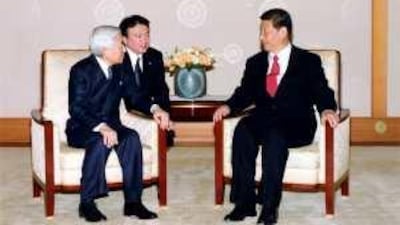China and Japan's emerging symbiosis could shift the locus of modern power completely away from the West, Howard W French writes. For the span of a few weeks this autumn, the theatre of global diplomacy found a rare focus in the audiences of Emperor Akihito of Japan, a figure without constitutional powers whose life is ordinarily spent in the shadows. The first half of the minuet in question is likely to be familiar, at least to news junkies in the West: the "scandal" that ensued, if only on American cable networks, after Barack Obama honoured the emperor with an unusually deep and deferential bow at his palace in Tokyo.
But the second act - which received far less attention in the headlines of the world's newspapers - was by far the more significant one. On unusually short notice for such a thing, Xi Jinping, China's number two and the slated successor to President Hu Jintao, was granted an audience with Akihito. Many warm words were exchanged, but there was no bow, at least none recorded by the cameras. Obama had come to Japan in part to soothe nerves - one might even say to curry favour - with a historically subservient but suddenly prickly ally whose new leadership is determined to chart a much more independent course for the country. Xi's visit, by contrast, was a shrewd mixture of bluster and tact, intended to press China's advantage as the country engineers a return to its customary role as the paramount force in Asian affairs.
Though Japan remains the world's second-largest economy, a decade of flat growth and a succession of mostly unremarkable leaders has left the world unaccustomed to looking toward Tokyo for important geopolitical signals. But the reorientation under way - best symbolised by the contrasting complexion of Obama and Xi's visits - marks one of the most significant new dynamics of our age. During his trip, Obama called himself America's first "Pacific president", a proclamation that is said to have unsettled some European chancelleries, and rightly so. The statement is a form of recognition, albeit belated and indirect, of a monumental shift in world affairs, whose centre of gravity is rapidly moving from the mid-Atlantic to the western Pacific.
That the tectonic plates of the international system, ordinarily so slow to move, have begun to reconfigure themselves with such speed is not merely a matter of China's impressive economic rise, which has been abundantly acknowledged. Far subtler, and yet potentially as important, has been Japan's new balancing act, as a new government in Tokyo emerges from America's politico-military apron. Under Prime Minister Yukio Hatoyama, whose Democratic Party of Japan ended decades of virtually uninterrupted rule by the Liberal Democratic Party at the end of August, Japan has embarked on a journey toward greater equidistance between its patron of the last six decades, the United States, and China, the country that has loomed largest in the island nation's life for 1,400 years.
While Japan learns to say no to the United States on important security matters, like the contentious issue of hosting US Marines on Okinawa Island, or on refuelling American military vessels bound for Afghanistan, it is placing increasing store on relations with China. China is already Japan's largest trading partner, and the prospect of decades of strong growth in the world's largest consumer market is almost certain to bring Tokyo closer to Beijing. America's long run of uncontested influence in Japan is doubtlessly ebbing.
Where might this all lead? In the last two decades, Japan has invested tremendous political capital and huge sums of money in trying to rebuild its relationship with Asia. At nearly every turn, however, it has been blocked by China, which has been much more successful at corralling the nations of South East Asia and conserving the most important diplomatic trump cards on the Korean peninsula. Today, many commentators have begun speaking a little hastily of a newly bipolar world; a condominium of sorts between the United States and China. But 20 years from now, this moment is likely to stand out for another important turning point, when China and Japan began to co-operate meaningfully on building Asian economic and eventually, perhaps, political bodies to rival the European Union.
The two countries will come to need each other not just for their markets and for investment, but for the management of their human resources. China, with its economic growth perhaps beginning to slow, needs to export people, and Japan, its own population nosediving, finally accepts the need to import them. If pursued successfully, this new symbiosis built on capital, technology and especially a growing cultural convergence between East Asia's two main powers will shift the locus of modernity for the first time from West to East. The US will not be suddenly chased from East Asia, but its era of predominance there will become a thing of the past.
As it increasingly discovers that getting things done means going through Beijing, Japan will abandon all pretence of containing China. But not wishing to kowtow to a new master any more than it did to an old one, it will resort to a classic game of balancing and will consequently find itself with an increasingly fine line to walk. Howard W French covered East Asia for the New York Times from 1998 to 2008, serving as bureau chief in Tokyo and Shanghai. He is the author of A Continent for the Taking: The Tragedy and Hope of Africa, and teaches at the Columbia University Graduate School of Journalism.

